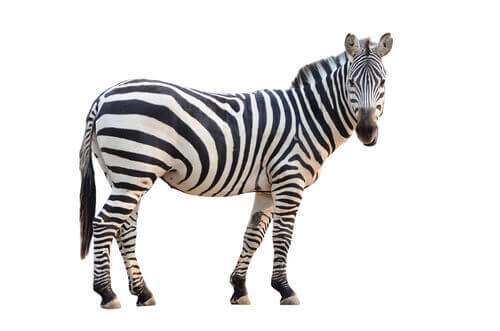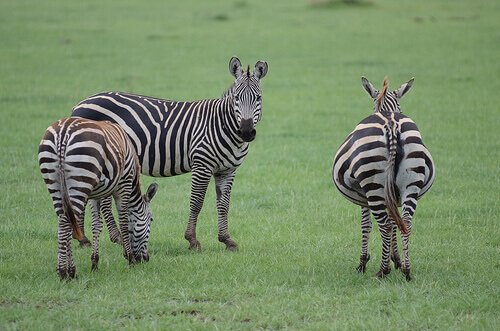Today's Question: Why Is a Zebra's Skin Striped?

The zebra’s skin makes this animal unmistakable. The black and white stripes that characterize it are a motif that many humans have imitated in many areas. In addition, fabrics for clothing and upholstery, and designs for decorative elements and cushions have set out to copy the original black and white striped design. However, why is a zebra’s skin striped? We’ll answer this question in today’s article.
Outside the realm of designers, zebra skin has also been the subject of scientific research. Over time, different theories have emerged about the reason and purpose for these particular stripes.
A zebra’s skin is its best defense
Science shows that, in nature, there’s always a deeper reason for any appearance. Protection, shelter, or camouflage are just some of the possible explanations why living beings look the way they do.
In general, the characteristics of an animal’s skin depend on the habitat in which they live. Using their skin, they protect themselves from the weather and from the aggression of other animals. It, therefore, has a defensive function that ensures the animal’s survival.
The type of skin an animal has (smooth, hairy, feathered, light, dark) allows for adaptation to the environment. As a result, the zebra isn’t an exception to this rule. Nevertheless, the stripes on its skin continue to be the subject of research and debate even today.
Why are there stripes on a zebra’s skin?
It’s important to note that much research has been done on this subject. Scientists have undoubtedly been attracted by the zebra’s original appearance for more than a century. As a result, possible explanations have followed one after another. However, new ideas emerge that detract from the previous ones and propose other possible reasons.

Three conclusions, all credible and possible, are the result of the most recent research. Moreover, zoologists continue to debate the validity and credibility of each one of them.
Camouflage
According to this theory, the stripes would help the animal to mimic the environment, and to blend in with the surroundings. As a result, they would remain out of a lion’s and a hyena’s field of vision, which are their main predators.
This theory puts forward the idea that the stripes on the zebra’s skin create an optical illusion that hides them. The black stripes would allow the zebras to blend in with the trees. Meanwhile, the white stripes would mimic the beams of light filtering through their canopies.
However, some research indicates that predators are able to locate them at a distance of more than 160 feet during the day and 100 feet at night. They perceive their silhouettes just as they do with other animals of the same size. In addition, the stripes, in this case, wouldn’t be of any use as protection.
Thermal effect
A study performed by the University of California explains the zebra’s stripes by pointing out that they tend to have more of them in hot habitats. In addition, the research was based on the discovery that not all zebras have the same number of stripes.
The number of zebra stripes is higher in areas where the temperature is higher. The warmer the habitat, the more stripes the zebra’s skin has. Interesting, isn’t it?

Horsefly and fly repellent
Zebras live in the savannah, a place full of vast grasslands. Moreover, you can find them near water sources, as it’s an animal that needs to drink water frequently.
In this geographical landscape, the zebra coexists with horseflies and tsetse flies, as well as blood-sucking insects. The black and white stripes on the zebra’s skin have been found to be a defense against these insects.
Studies have been conducted in Hungary and Sweden, and experimentation has been done on black, brown, and white horses. As a result, scientists found out that the insects prefer darker coats.
But what happens with zebra stripes? Well, the narrow black and white pattern in their stripes causes a special effect when reflecting light. The conclusion is that zebras have an optimal skin design to create the least possible attraction for insects.
The general tendency of zoologists is to think that there’s no single valid reason. The stripes on the zebra’s skin are probably due to many factors that make this animal one of the most eye-catching equines on the planet.
What do you think about these hypotheses? We hope you enjoyed learning more about this interesting animal!
